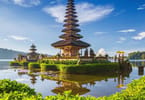PHUKET (eTN) – They are very few cities in Thailand which could claim to have a well preserved historical old town such as Phuket city. The resort island is well known for its beaches, superb resorts, and entertainment areas. However, few tourists still venture in the narrow streets of Phuket’s old town in a triangle delimited by Thalang, Dibuk, and Krabi Roads. In this relatively small area, rows of 100-year-old shophouses and villas were built at the height of the tin-mining boom. In Thailand, these houses are known as “Sino-Portuguese” – mostly for political reasons – but they were, in fact, typically designed in “Peranakan” style – a blend of Malay and Chinese cultures, which still predominates today in Malacca, Penang, Singapore, and in some parts of Sumatra and Java. Many of the houses bear the same adornments, stucco, and multi-colored tiles of their counterparts in old Malaya. Most of the Chinese traders who settled in Phuket at the end of the 14th century came from the Malaysian Peninsula.
Phuket’s old town was neglected until recently when trendy small bars, coffee shops, bakeries, and guest houses started to take over some of the derelict buildings, breathing new life into them. The result has been amazing: little architectural jewels have been carefully renovated, while tourists and locals are starting to come again to the old town in the evenings for entertainment. Even infamous suspended cables which “grace” most streets of Thailand’s cities have been put underground, such as in Thalang Street.
One of the most prominent buildings in Phuket’s old town, the “Khaluehaad Phra Phitak Chin Pracha” House, is experiencing a renaissance. The magnificent house, called also the “Phuket Governor Mansion,” was built in the Italian neo-renaissance style and is surrounded by hectares of gardens. It has been taken over by the Blue Elephant Company, which has successfully made a name around the world with fine dining restaurants in Brussels, Dubai, Jakarta, London, and Paris serving authentic Royal Thai cuisine.
“The Phuket Governor Mansion was the right opportunity to offer our traditional cuisine in a magnificent house. It was a big investment with restoration lasting for two years. But we are now so pleased by the result and very proud to have returned this house to its former glory,” said Kim Steppé, general manager of the Blue Elephant Governor Mansion, which offers both a restaurant and cooking school.
Mr. Steppé’s ambition is to provide, through the Blue Elephant, a new way to promote and protect the wonderful heritage of old town in Phuket. “We consider our house as a prominent landmark in the area, a kind of embassy of Phuket old town. We were very touched to see many Thais coming to express their thanks for preserving their heritage. I hope that it will set up an example for other owners to preserve their houses,” he added. Giving more exposure through prestigious venues would be the best way to preserve the area. “It would be a real boon for this part of Phuket,” said the young manager.
Mr. Steppé is also looking to organize special events, inviting famous DJs to play in the mansion to attract a younger crowd. And to show that the Blue Elephant is not as expensive as some may imagine, a high tea corner has been created offering savories at very affordable prices. “Unfortunately, unlike in Europe today, preserving historical places is not always a priority in Thailand, as many people still prefer modern facilities or look for a short-term investment. It takes time, but I am confident that an increasing number of Thai investors will understand the value of such an investment in heritage,” told Kim Steppé.
It will, in fact, take a lot of time to be sure that the message gets across the board and that the provincial government of Phuket starts to enforce laws to efficiently preserve the area. Next door to the Blue Elephant Mansion stands another magnificent mansion, the Chinpracha House. With its dark blue windows and white facades, the 1907 mansion was one of the few opened to the public by its owner, Janoorat Tandavanich, who turned it into a museum of Peranakan lifestyle. The house was surrounded by a vast garden with iron fences decorated with art nouveau flower motifs, specially imported from Holland.
“Was” is the sad reality of Chinpracha House, as the garden and the fences are already gone, replaced by atrocious commercial buildings. The Chinpracha House is now closed to the public and is surrounded by aluminum fences, an indication that it might soon be demolished. Phuket would then loose another invaluable asset, although it is not known if the locals really would mobilize to preserve the mansion. Many other old villas and houses, less known than the Chinpracha House, are slowly disappearing due to a lack of preservation. “It would be great if Phuket’s old town[‘s] invaluable history could be [put] on UNESCO’s World Heritage list,” dreamed Mr. Steppé. The dream still needs to be shared.
WHAT TO TAKE AWAY FROM THIS ARTICLE:
- It will, in fact, take a lot of time to be sure that the message gets across the board and that the provincial government of Phuket starts to enforce laws to efficiently preserve the area.
- But we are now so pleased by the result and very proud to have returned this house to its former glory,” said Kim Steppé, general manager of the Blue Elephant Governor Mansion, which offers both a restaurant and cooking school.
- Steppé's ambition is to provide, through the Blue Elephant, a new way to promote and protect the wonderful heritage of old town in Phuket.






















